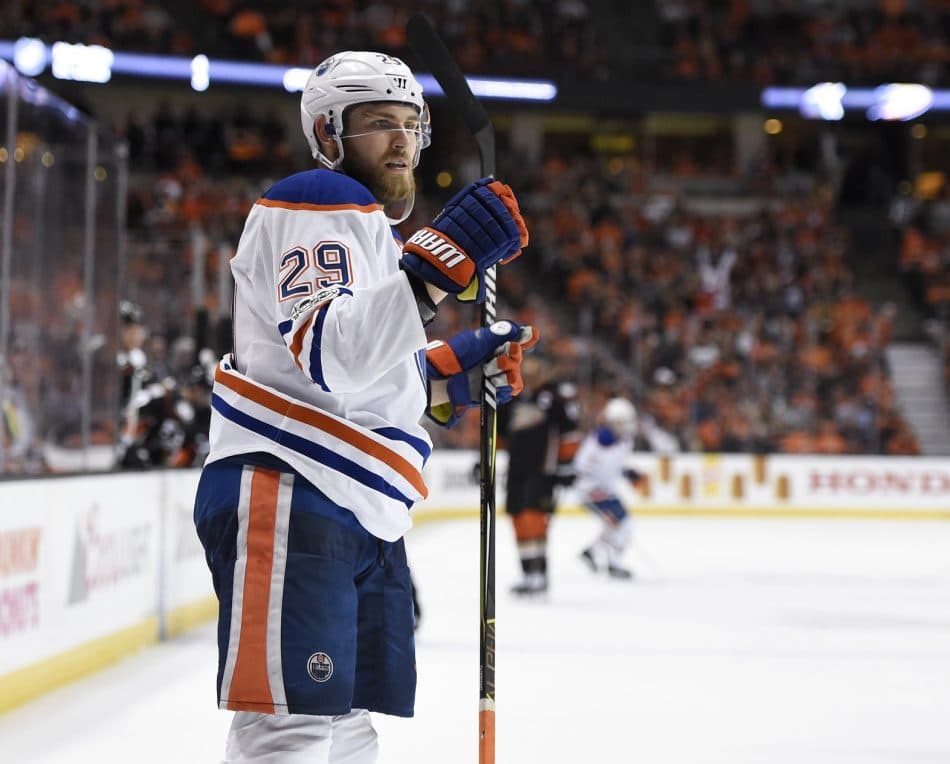2016-17 Edmonton Oilers: No. 29 Leon Draisaitl
When Leon Draisaitl signs what is sure to be a very rich, very long second NHL contract this summer, he should probably spare a moment to be thankful to his head coach. After all, it was Todd McLellan who became convinced that Draisaitl was the best player on the roster to work with Connor McDavid, thereby ensuring that the third-year centre was given every opportunity to run up his scoring numbers.
David Johnson’s indispensable stats.hockeyanalysis.com tells us that Draisaitl went from scoring 1.80 points/hour (at 5-on-5) away from McDavid up to 2.24 points/hour with him. That’s a 20-25 percent jump in scoring efficiency, turning Draisaitl from a good offensive player into a great one. It’s also pretty much in-line with what Evgeni Malkin and Sidney Crosby do for their wingers in Pittsburgh.
Draisaitl seems to help McDavid, too. Edmonton’s captain saw his scoring increase by about 10 percent at evens when he played with Draisaitl vs. when he played without him.
There’s also, obviously, the power play factor. Draisaitl’s power play points year-over-year tripled, primarily as a result of being put on the McDavid unit. There shouldn’t be much doubt as to who is primarily driving the success of that top unit.
The most interesting Draisaitl/McDavid comparison is the performance of those two players’ respective lines when they’re together and when they’re apart:
As one line, they do pretty well. Edmonton got 54 percent of all shot attempts and scored almost 60 percent of all goals when that line was on the ice.
The problem is that without Draisaitl, McDavid’s line is still awesome, collecting 52 percent of all shot attempts and 66 percent of all goals. Without McDavid, Draisaitl’s line was outshot (just 48 percent of the Corsis) and outscored (worse, only 44 percent of all goals).
That takes us back to the question posed in our introduction: How worried should the Oilers be? In my opinion, not very. Here are the wingers who spent at least 100 minutes (ranked by total ice-time) with McDavid and Draisaitl in their time apart from each other:
- McDavid: Eberle (399 minutes), Lucic (377), Maroon (192)
- Draisaitl: Maroon (200 minutes), Lucic (135), Slepyshev (108), Puljujarvi (104), Pouliot (100)
It’s fashionable to hate on Jordan Eberle in Edmonton these days, but despite a disappointing season and a worse playoffs, he remains a dramatically better right wing in the here-and-now than Anton Slepyshev and Jesse Puljujarvi. That’s probably something the Oilers keep in mind when they’re making decisions this summer.
McDavid’s line also had the virtue of stability. He had Lucic or Maroon at left wing, and Draisaitl or Eberle at right wing. Draisaitl instead alternated between centre and wing and played with alternating wingers for good measure.
But while the Oilers probably shouldn’t be too worried about Draisaitl’s numbers away from McDavid, they should obviously be aware of the influence their team’s captain has had on their second-best forward. If the plan down the road is to play them on separate lines – and it’s a plan I’m in favour of, as not only did it look good late in the playoffs but it’s the same strategy taken by virtually every successful team over the last decade (Crosby and Malkin, Toews and Kane, Kopitar and Carter) – there’s going to be an offensive cost paid by Draisaitl for playing with lesser talent.
In a perfect world, the Oilers would be paying Draisaitl based on his offensive numbers away from McDavid. Instead, they’ll pay for what he did on a line with the guy who should be the NHL’s MVP this season. Edmonton will just have to hope that Draisaitl’s continued offensive development (he’s only 21) will make up the gap if the two are separated down the road.
Previous year-end reviews:
- Centre: David Desharnais
- Left Wing: Milan Lucic, Patrick Maroon, Matt Hendricks
- Right Wing: Jordan Eberle, Tyler Pitlick, Iiro Pakarinen
- Left Defence: Andrej Sekera, Darnell Nurse, Griffin Reinhart
- Right Defence: Adam Larsson, Kris Russell, Mark Fayne
- Goal: Laurent Brossoit

